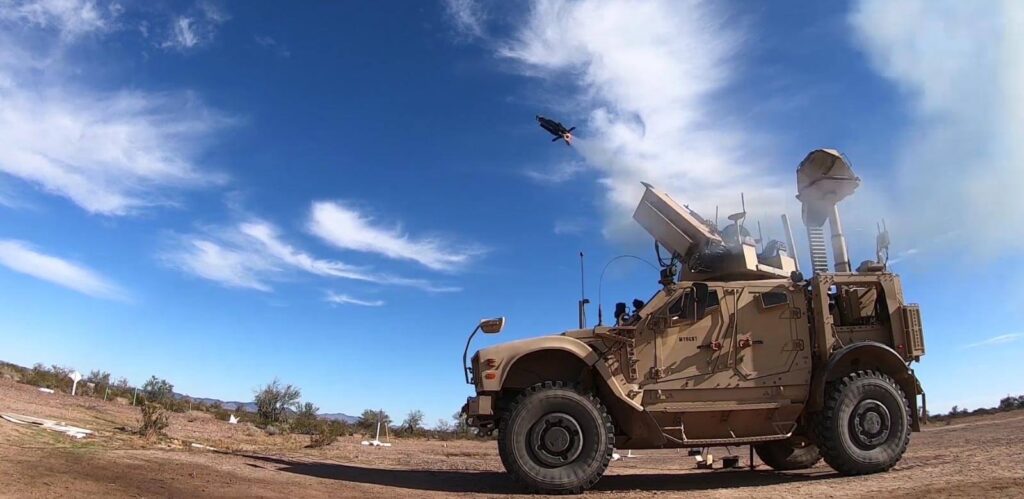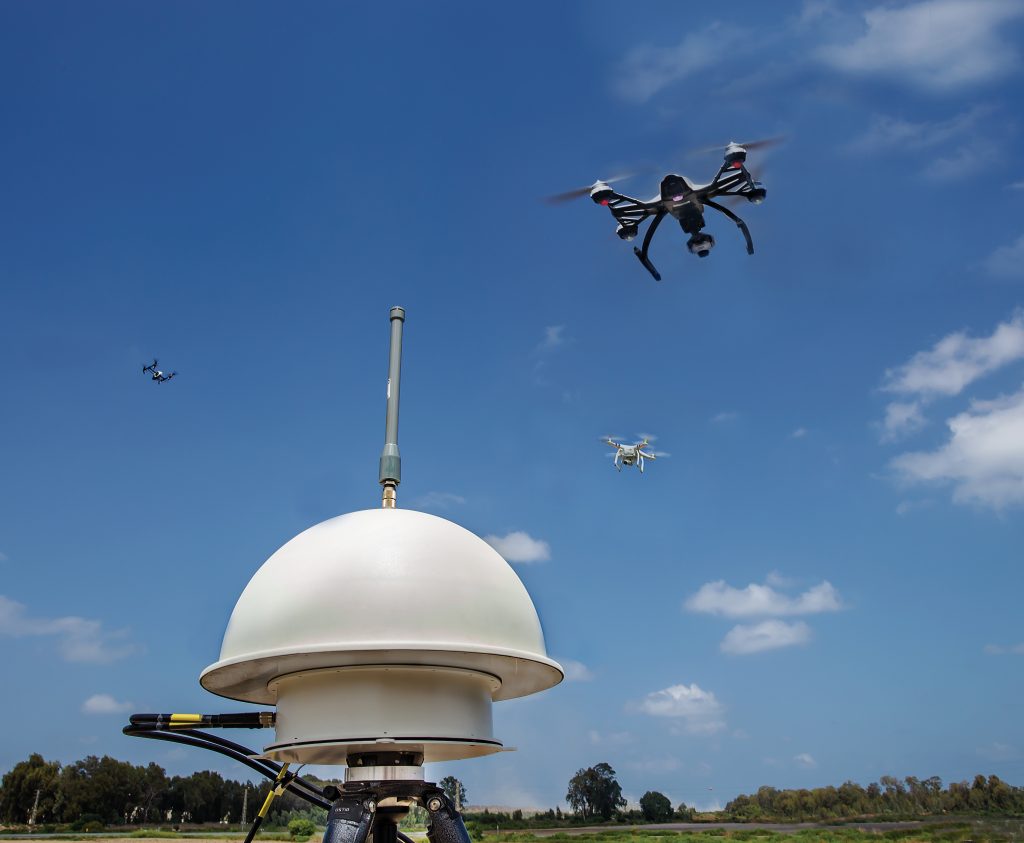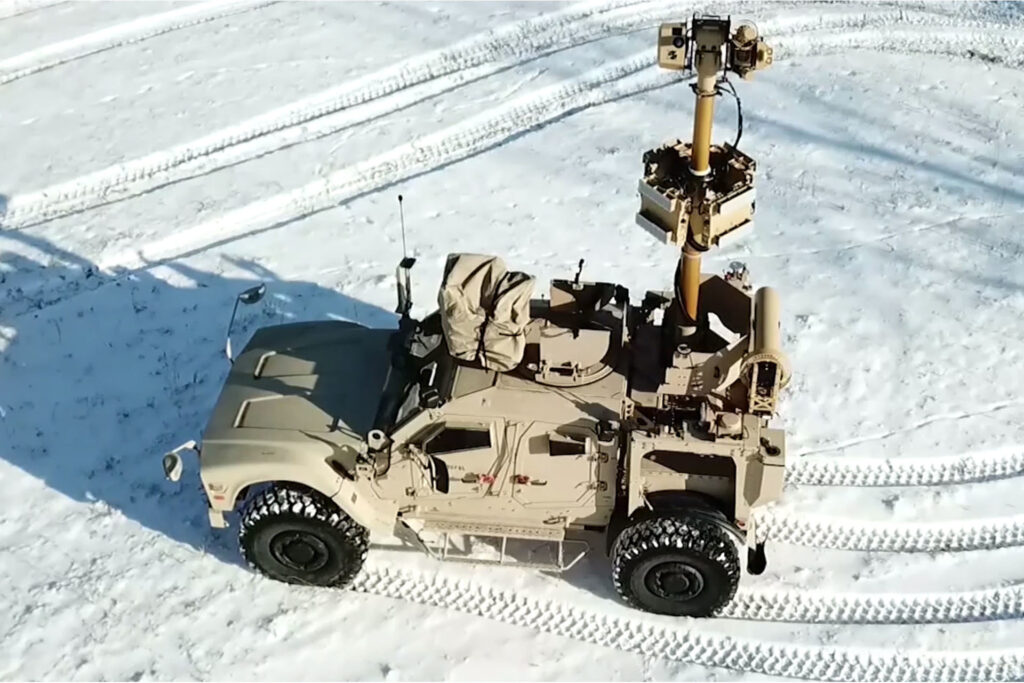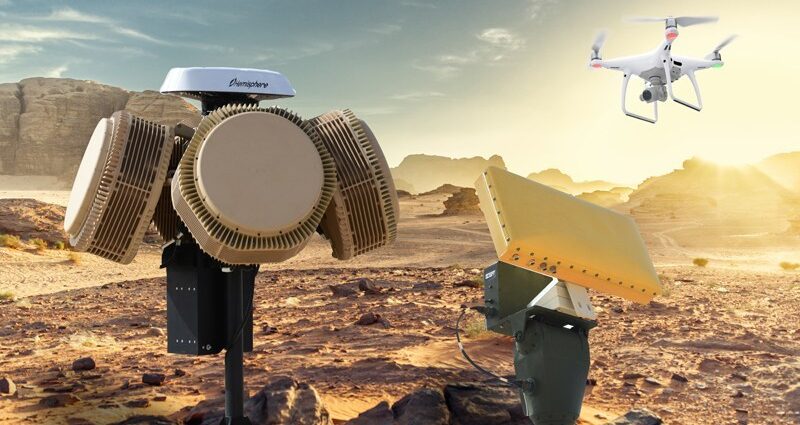The burgeoning use of drones across various sectors, from commercial deliveries to military operations, has brought with it a new set of challenges, particularly regarding unauthorized or malicious drone activity. In response to these evolving threats, counter-drone systems (C-UAS) have emerged as a critical area of technological development, encompassing diverse strategies for detecting, tracking, classifying, and mitigating rogue drones.
For a great overview, listen in to our Defense Week podcast, the “Deep Dive” with world-leading experts:
Detecting the Unseen: A Multi-Sensor Approach
- Radar Systems: Both active and passive radar systems play a vital role in drone detection. Active radar, such as those operating in the Ka, Ku, X, C, and S bands, emits radio waves and analyzes the echoes reflected from targets. Passive radar, on the other hand, exploits existing electromagnetic signals like TV or radio broadcasts to detect drones by analyzing their reflections on these ambient signals.
- Electro-Optical/Infrared (EO/IR) Sensors: EO/IR sensors leverage the visible and infrared portions of the electromagnetic spectrum to detect and track drones. Visible cameras provide high-resolution images, while infrared cameras, particularly thermal imaging systems, detect heat signatures, making them effective even in low-light conditions.
- Acoustic Sensors: Acoustic sensors, such as microphone arrays, are used to detect the unique sound signatures produced by drone motors, rotors, or propellers. They are especially useful in environments where visual detection is challenging, such as urban settings or areas with dense vegetation.
- Radio Frequency (RF) Signal Analyzers: RF analyzers are employed to detect and analyze the communication signals between the drone and its operator, typically within the 2.4 GHz and 5.8 GHz frequency bands. By intercepting and analyzing these signals, C-UAS systems can identify the drone, track its movements, and potentially even disrupt its communication.
- LiDAR Systems: LiDAR (Light Detection and Ranging) systems use laser pulses to create highly accurate 3D maps of the environment, allowing for the detection and tracking of drones based on their position and movement patterns. LiDAR offers high resolution and accuracy, making it suitable for identifying and classifying drones even in complex environments.

Mitigating the Threat: Soft Kill vs. Hard Kill
Once a drone has been detected and classified, C-UAS systems employ various mitigation techniques to neutralize the threat. These techniques generally fall into two categories:
Soft Kill: Soft kill methods aim to disable or disrupt the drone’s operations without causing physical damage. These methods include:
- RF Jamming: RF jamming disrupts the communication link between the drone and its operator by emitting interfering signals on the same frequency band. This can force the drone to enter a fail-safe mode, land, or return to its starting point.
- GPS Spoofing: GPS spoofing involves sending false GPS signals to the drone, misleading it about its actual location. This can disrupt navigation, causing the drone to deviate from its intended course or initiate an unplanned landing.
- Cyber Attacks: Cyber attacks target vulnerabilities in the drone’s software or communication systems. By exploiting these weaknesses, attackers can disable the drone, gain control, or extract sensitive data.
- Directed Energy Weapons (DEWs): DEWs, in a non-lethal capacity, can be used to disrupt the drone’s electronic systems without causing permanent damage. High-energy lasers or high-powered microwaves can temporarily disable the drone by targeting sensitive components.
Hard Kill: Hard kill methods, primarily used in military applications, involve physically destroying or damaging the drone. These methods include:
- Projectile-Based Systems: This involves using projectiles, such as bullets or specialized ammunition, to shoot down the drone.
- Directed Energy Weapons (DEWs): In a lethal capacity, high-energy lasers can be used to destroy critical components of the drone.
- Explosive-Based Systems: This involves using missiles or other explosive devices to destroy the drone

The Future of Counter-Drone Technology
Counter-drone technology is a rapidly evolving field. As drone technology advances and becomes more accessible, the development of effective C-UAS solutions remains paramount. Future trends in this field include:
- Increased Integration of Artificial Intelligence (AI): AI is playing an increasingly important role in C-UAS, particularly in areas such as threat classification and the automated selection of appropriate countermeasures.
- Enhanced Sensor Fusion: The integration of multiple sensor technologies through advanced sensor fusion algorithms will enhance the accuracy, reliability, and resilience of C-UAS systems.
- Development of Non-Kinetic Countermeasures: There is a growing focus on developing non-kinetic countermeasures, such as acoustic or directed energy weapons used in a non-lethal capacity, to provide more flexible and proportionate responses to drone threats.
- Emphasis on Cybersecurity: As drones become more reliant on software and interconnected systems, addressing cybersecurity vulnerabilities and protecting against cyber attacks will be crucial for ensuring the integrity and effectiveness of C-UAS.

Main Global Players
| Company / Product / Country | Technology |
| Lockheed Martin Morfius, USA | A reusable defensive C-UAS. Enables multi-engagement and swarm defeat at longer ranges than ground-based systems. No specific information about detection sensors, classification, and tracking is provided. Mitigation action is categorized as hard kill. |
| Raytheon Coyote, USA | A drone used for a near-term C-UAS solution. It is equipped with an advanced seeker and a warhead. It can be operated up to one hour and is designed for interchangeable payloads. No specific information about detection sensors, classification, and tracking is provided. Mitigation actions are categorized as hard kill. |
| Northrop Grumman M-ACE, USA | M-ACE is a modular ground-based C-UAS solution. It utilizes three-dimensional radar, radio frequency sensors, electro-optical/infrared cameras, global positioning systems, and secure radio for transmitting information over command-and-control networks. Mitigation actions (hard kill) are conducted by kinetic/non-kinetic defeat options (e.g., bushmaster cannon with advanced ammunition, directed energy solutions). |
| General Dynamics Dedrone, USA | Denominated as the Expeditionary Kit, it was developed in response to a mission need for a mobile ground C-UAS capability. It can be deployed in less than an hour. The system includes radio frequency sensors with a range up to 1.5 km (ideal conditions). It uses a classification engine which recognizes and classifies commercial, consumer, and hobbyist drones. It is based on the drone RF signature. Mitigation action (soft kill) is done by GNSS (Global Navigation Satellite Systems) and remote-control disruption of the system. |
| Highpoint Aerotechnologies Liteye, USA | It is a portable perimeter defense system against autonomous, unmanned, and multi-domain threats. The solution can be containerized for rapid deployment. No specific information about sensing systems is provided. It includes AI & analytics for threat classification. Drone mitigation can be carried out through soft kill (high-precision directional RF jamming) or hard kill (hunter-seeker drones or kinetic weapons). |
| Blighter Surveillance Systems AUDS, UK | AUDS is a strategic C-UAS system designed to disrupt and neutralize drone threats. It includes detection, tracking, and defeat capacities. It uses air security radar (Ku-band) with a detection range of 10 km and a minimum target size of 0.01 m2; and a digital camera tracker (color HD camera with 2.3 MP and optical zoom x30 and thermal camera with 640×512 pixels). Mitigation actions are performed with an intelligent software-defined RF inhibitor with a high gain quad-band antenna system (includes GNSS frequencies). |
| MSI-Defence Systems Terrahawk Paladin, UK | It is a containerized, modular, remote-controlled and re-deployable C-UAS system. It includes sensors (electro-optic) and effectors mounted under NATO-standard. Drone tracking is done using AI algorithms. Mitigation is carried out using the MSI-DS Terrahawk LW Series gun mount (hard kill). |
| Thales Group EagleShield, France | It is an integrated nano, micro, mini, and small drone countermeasures solution to protect and secure civil and military sites. It combines different sensors, such as radars and cameras, along with warfare technologies to detect, monitor, and neutralize drones in the airspace. No specific information about the sensing and mitigation systems is provided. |
| Elistair Orion 2.2 TW, France | It is a tethered drone station that can provide continuous surveillance and security for sensitive sites, offering a passive defense against unauthorized drones. Although it has no mitigation systems and is mainly based on an elevated observation platform, it is included in this work as it presents a disruptive concept far from most existing C-UAS systems. |
| Elbit Systems ReDrone, Israel | ReDrone is a multi-layered defense against UAV threats. It presents multiple deployment options in mobile or stationary configurations. It utilizes different sensing technologies for detection and tracking, such as: 3D radar, electro-optical / infrared (EO/IR) day & night cameras, Signals Intelligence (SIGINT) and acoustic sensors. Mitigation actions are based on soft kill (jamming actuating and/or navigation protocol. Hard kill is performed with a drone-kill weapon system and high-accuracy stabilized gunfire. |
| Israel Aerospace Industries Drone Guard DG5, Israel | Drone Guard is a C-UAS solution that provides drone detection and disruption. The system includes different sensors to detect, track, and classify the target, such as: 3D radar, EO/IR cameras, SIGINT, and Communications Intelligence (COMINT). Mitigation is carried out with a directional RF jammer. |
| Rafael Advanced Defense Systems Drone Dome, Israel | Drone Dome is a modular system that can be deployed as a C-UAS mobile or stationary unit. The solution integrates radar, SIGINT/RF sensor, and EO sensor. Mitigation actions are based on a jammer (soft kill) which blocks the signal and command from the remote control. It also jams the video transmitted by the drone to the operator and the GNSS signal to disrupt drone navigation and control. It can also be equipped with hard-kill capacities. |
| CONTROP Precision Technologies TORNADO-ER, Israel | It can detect and track drones from large distances up to 12 km. The system was developed for diverse land environmental conditions. The detection system is based on gyro-stabilized electro-optical and thermal imaging sensors combined with real-time video algorithms. Mitigation actions can include kinetic or non-kinetic countermeasures. |
| MCTECH RF Technologies MC Horizon, Israel | MC Horizon system provides a comprehensive defense against micro and mini drones. It utilizes a combination of radar, RF detection, and electro-optical sensors. Mitigation is carried out through RF and GNSS jamming (soft kill). |
| INDRA Crow, Spain | The system incorporates a mobile command and control unit, allowing for flexible deployment and coordination with other security systems. The sensing system is based on radar, EO/IR cameras, and RF detectors. Mitigation actions are performed through RF and GNSS jamming (soft kill). |
| SDLE Antridone, Spain | A portable handheld solution that can be installed in vehicles and moving platforms. The manufacturer does not provide information about detection sensors, threat classification, or tracking systems. Mitigation actions are done disrupting remote control, telemetry, video link, and GNSS navigation. |
| Leonardo FalconShield, Italy | It is a scalable and modular system oriented to slow and small drones. It utilizes radar and Electronic Surveillance Measures (ESM), combined with Electro Optical (EO) sensors and advanced Radio Frequency (RF) effector technology. Threat detection and tracking includes automatic capabilities to minimize the operator workload. Mitigation actions include electronic attack (capable to deny, disrupt, or defeat UAV command, control, navigation) and UAV data downlinks. |
| SAAB AB 9LV, Sweden | It enables integrating a range of sensors for drone localization, classification, and recognition. These sensors integrate RF protocol detection, direction finding, and 2D radar. The Command and Control (C2) function in SAAB’s 9LV C-UAS system employs non-cooperative kinematic threat intent assessment and incorporates both anomaly detection and spatio-temporal movement pattern analysis. Mitigation actions support integrating a variety of effectors to enable drone capability, including RF jammers and GNSS denial systems (soft kill), and high-energy laser systems, physical capture, fouling drones, and small to medium caliber guns with a high rate of fire and air-burst ammunition. |
| HENSOLDT Xpeller, Germany | It is a modular system with includes radar for airspace monitoring and digital cameras (color, black/white and thermal). Drone tracking is carried out by specific algorithms that calculate the trajectory and the potential target point of the drone. Data from all sensors is fused into a comprehensive recognized air picture and presented in the command-and-control system. The mitigation is provided by a C-UAS jammer (soft kill). In the near future, they will provide autonomous catcher drones and high-energy lasers. |
| Rheinmetall AG Drone Defence Toolbox, Germany | It is a multi-sensor modular C-UAS system, which combines radar and EO/IR systems for drone detection, classification and tracking. Mitigation actions are carried out through different systems such as: high-power electromagnetic effectors and interceptors. |
| Department13 Map13, Australia | They offer C-UAS solutions designed to detect, identify and mitigate drone threats using radio frequency-based techniques. There is not specific information about the detection sensors, classification algorithms, and tracking capabilities, as well as the mitigation technologies used. No images of the system were found. |
| EOS Slinger, Australia | The system combines a 4-Axis electro-optical sensor unit with an echodyne radar for drone detection and tracking. Mitigation action is done by an M230LF cannon with proximity sensing ammunition. |
| Zala Aero Group Aerorex, Russia | It is mainly a mitigation system (soft kill) with three signal suppression modules for 2.4 GHz and 5.8 GHz frequencies, as well as for satellite navigation signal suppression. |
| Roselektronika Zaschita, Russia | It consists of a set of passive sensors that do not emit any radiation. To detect the target, they use external signals, such as those from digital television, which bounce off the drone. Permission is not required for the use of radio frequencies, facilitating civilian use. However, passive sensors present lower detection capabilities. EO / IR sensors are likely not integrated into the system. Drone mitigation is performed by radio wave jamming. |
| China Electronic Technology Group Corporation YLC-48, China | YLC-48 system combines 3D S-band low-altitude surveillance radar and jamming technology to detect and counter unauthorized drones (soft kill). |
| DJI Aeroscope, China | Aeroscope system is designed to identify and monitor drones in restricted areas, providing authorities with information to manage and control UAV operations. It covers a range of up to 50 km. It analyzes the electrical signals between drones and remote control. The datasheet does not provide information about the sensing unit and the mitigation actions provided by the system |
| ASELSAN iHTAR, Turkey | C-UAS system to neutralize mini and micro drone threats in urban and rural areas. It utilizes various sensors for detection, including radar, acoustic, and EO/IR sensors. For mitigation, it employs jamming systems targeting RF communication and GPS signals. Additionally, it incorporates a laser-based hard kill solution for destroying drones. |
| Kongsberg CORTEX Typhon, Norway | It integrates radar, electro optic, and Teledyne FLIR thermal cameras for drone detection. The system works in combination with the Kongsberg Remote Weapon Station for threat mitigation (hard kill). |
The field of counter-drone technology is undergoing a period of rapid innovation and development. As the use of drones for both beneficial and malicious purposes expands, the need for robust and adaptable C-UAS solutions is becoming increasingly critical. Continued investment in research and development, along with collaboration between industry, governments, and research institutions, is crucial for ensuring effective counter-drone capabilities in the years to come.


Comments are closed, but trackbacks and pingbacks are open.